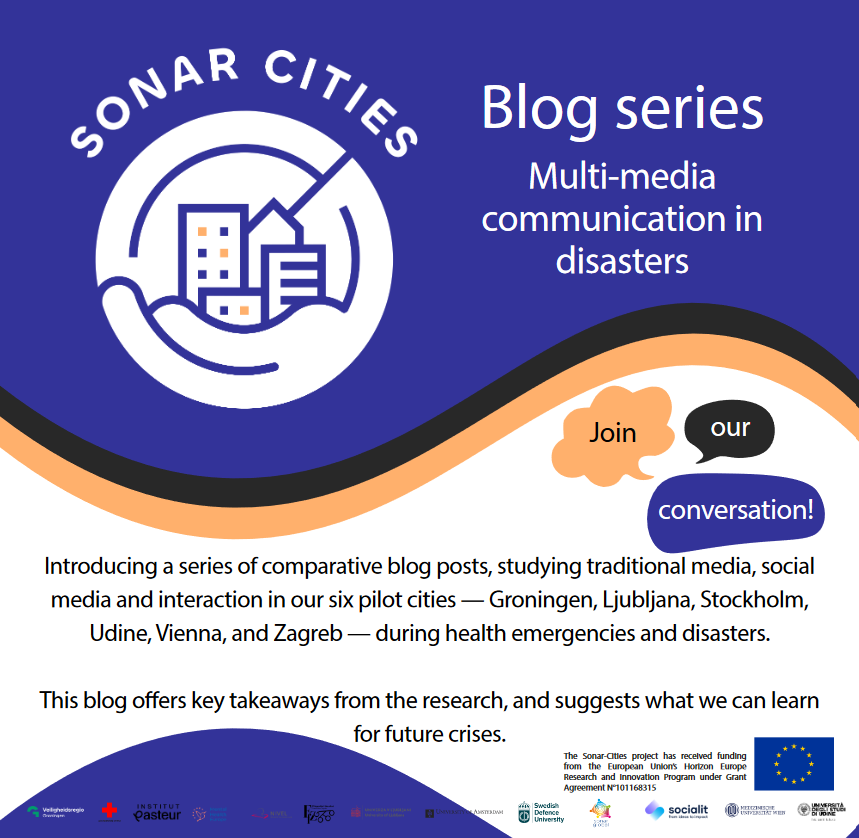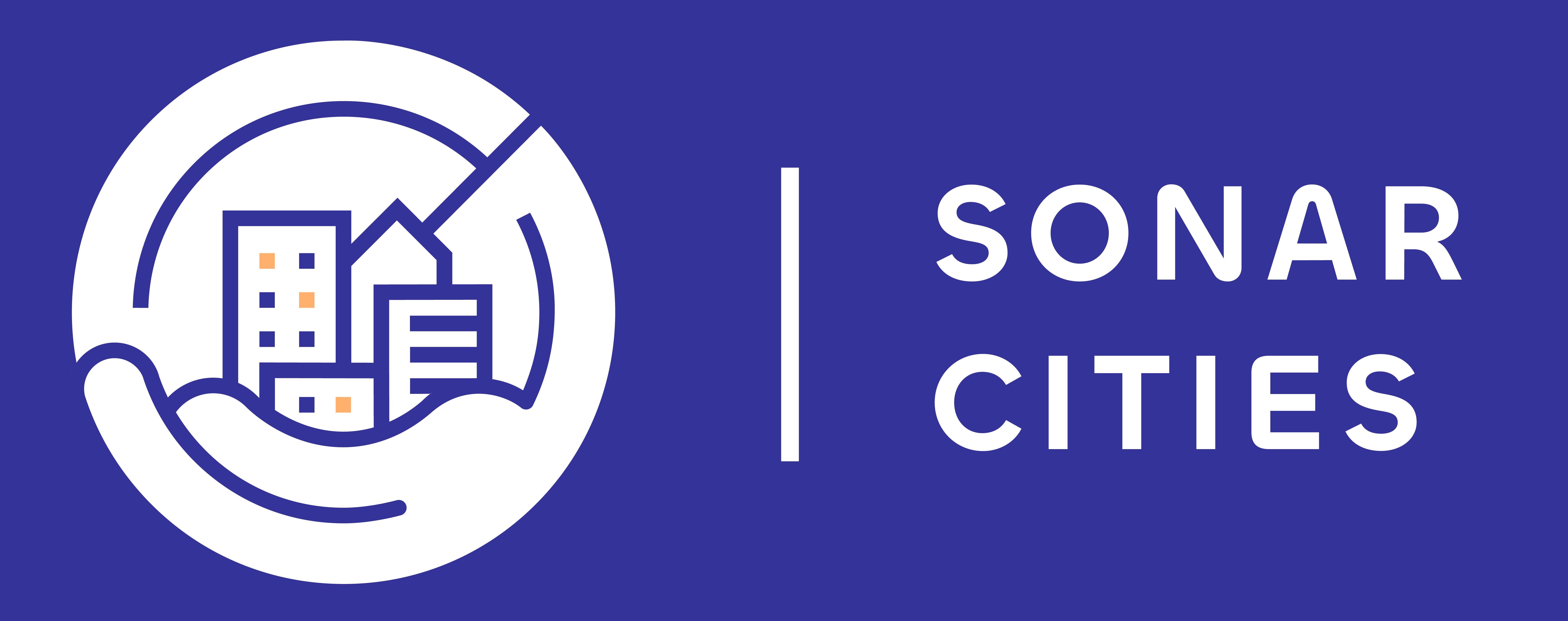Blog post n°2
How do media communicate vulnerability?
Disasters—whether earthquakes, floods, or extreme weather—do not affect everyone equally. Some groups face greater risks due to age, health, economic status, or living conditions. But how do cities and the public define who is “vulnerable” during a crisis?
The Sonar-Cities Project examined this question across five European cities—Groningen, Ljubljana, Udine, Vienna, and Zagreb—by analysing traditional and social media during past disasters. Each city conducted an in-depth analysis of disaster communication strategies, with a focus on recent and impactful extra-ordinary events. Vienna examined its response to the intense heatwaves of summer 2024. Udine investigated extreme weather events, particularly the devastating hailstorm that hit Mortegliano in 2023. Groningen studied communication around gas-mining-induced earthquakes, especially in the 2023 timeframe. Ljubljana focused on the August 2023 Slovenian floods. Finally, Zagreb revisited the lessons from the March 2020 earthquake.
The findings reveal striking differences in how vulnerability is perceived, often shaped by the type of disaster and local social structures.
Traditional Media: How Newspapers Frame Vulnerability
Udine: Socioeconomic Vulnerability Takes Center Stage – When extreme weather hit Udine, the media primarily highlighted economic hardship. Farmers, small business owners, and families who lost homes or livelihoods dominated coverage. These groups were portrayed as struggling to recover without financial means. Less frequently mentioned were the older adults, people with disabilities, or those attempting risky self-repairs. The narrative focused on material losses—destroyed homes and damaged businesses—rather than deeper social inequalities.
Zagreb: Housing Instability and Health Risks After the Earthquake – After Zagreb’s earthquake, the most vulnerable were those who lost homes or lived in unsafe buildings. Hospital evacuations—especially for pregnant women, newborns, and cancer patients—also drew attention. However, narratives rarely extended to other at-risk groups, such as the homeless or low-income families not directly impacted by structural damage.
Vienna: Heatwaves and Hidden Vulnerabilities – Vienna’s media linked vulnerability during heatwaves to age (older adults and children), pre-existing health conditions, and poverty. Homeless individuals and migrants were occasionally mentioned, but the broader conversation centred on access to cooling resources and concerns around unsafe housing.
Groningen: Universal Vulnerability in Earthquake Aftermath – In Groningen, nearly all homeowners were considered vulnerable due to earthquake risks. Only children and young adults were singled out as needing special attention, suggesting a perception that the crisis affected the population uniformly.
Ljubljana: Floods and the “Everyone is Vulnerable” Narrative – Ljubljana’s floods led to a broad characterization: anyone affected was vulnerable. The media rarely explored how marginalized groups (e.g., low-income or people with disabilities) faced compounded risks. Instead, the focus was on immediate material needs—cleaning, financial aid—rather than long-term psychological or social support and, alongside people, businesses were also framed as “at risk”.
Social Media: Highlights of the Public Perceptions and Situational Vulnerability
Udine: Vulnerable Groups Framed as Recipients, Not Participants – Institutional analysed accounts in Udine rarely specified vulnerable groups, often depicting them as passive recipients of aid, rather than active participants in emergency response or recovery. One exception was a toolkit for people with cognitive disabilities—a rare acknowledgment of specific needs.
Zagreb: Mental Health and Children in Focus – While housing damage remained a key concern, social media highlighted mental health struggles, especially among children. Unlike traditional media, platforms like Twitter saw posts on emotional trauma; a less visible but critical aspect of vulnerability.
Vienna: Generalized Warnings, Few Specifics – Social media posts from institutions often avoided naming vulnerable groups, instead issuing broad heatwave advice. Only a few mentioned specific health risks like heat stroke or dehydration, but without explicitly targeting high-risk populations such as older residents or outdoor workers.
Groningen: Solidarity Over Specific Vulnerability – Social media communication focused on collective responsibility (e.g., “Follow rules to protect others”) rather than speaking to specific vulnerable groups. Unlike traditional media—which framed all homeowners as at risk— social media platforms emphasized community resilience, with only occasional mentions of children’s safety.
Ljubljana: Vulnerability as a Consequence of Disaster – On social media, flood victims were seen as vulnerable because of the disaster, not because of pre-existing conditions. Posts emphasized post-flood risks—mould, landslides, trauma—but rarely identified at-risk groups unless directly impacted.
Besides the specific insights emerging from individual case studies, in the public characterization of who was deemed vulnerable, institutional accounts generally avoided explicit vulnerability framing (e.g., Groningen’s legalistic approach, Vienna’s general heatwave advice) while emergency management posts were more action-oriented but still with a limited informative scope (e.g. Zagreb prioritized support for immediate risks, while Udine vaguely referenced “displaced families”). A peculiar result emerged from Ljubljana’s case, where institutions already promoted narratives focused on reconstruction, whereas emergency bodies emphasized safety protocols – but in both cases, providing little attention to underlying systemic vulnerabilities such as poverty.
The analysis carried out also inspected the differences between the posts and comments on the accounts considered; posts revealed a general focus on the procedural updates previously described. The analysis of comments, instead, revealed more emotional aspects such as the frustration of the citizens. For example: Zagreb saw praise for responders but anger over delayed aid, and Ljubljana’s comments mixed gratitude with political critiques, exposing trust gaps.
Key Takeaways: How Disasters Shape Perceptions of Vulnerability
- Economic Vulnerability Dominates: Small business owners, farmers, and displaced families frequently appear in media narratives.
- Social Media Highlights Hidden Struggles: Mental health and long-term trauma get more attention online than in traditional media.
- Gaps in Recognizing Marginalized Groups: Homeless individuals, non-native speakers, and people with disabilities are often overlooked unless directly impacted.
Conclusion: Towards More Inclusive Disaster Preparedness
Understanding who is deemed vulnerable shapes how cities respond to crises. While traditional media often focuses on visible, immediate hardships, social media can reveal less obvious struggles—like trauma and mental health.
What can be done?
- Authorities should ensure communication includes – and is comprehensible for – marginalized groups.
- Media can broaden narratives to address long-term vulnerabilities.
- The public can advocate for more inclusive disaster planning.
Share this post to raise awareness! The more we recognize diverse vulnerabilities, the better cities can protect everyone in times of crisis.
Stay informed—follow the Sonar-Cities Project for more insights on disaster resilience. Sign up to our mailing list!
Methodological note
City specific disaster data analysis examined material during the first month of each disaster across five cities. Traditional media analysis used a qualitative thematic approach, selecting one newspaper per city based on archive access, circulation, and local relevance. The final dataset included 691 articles, with 30 per city (one daily) on “vulnerability”, except Groningen (12) and Vienna (15), that were analysed.
For social media, four accounts per city (two institutional, two emergency-related) were analysed, prioritizing official, accessible, and locally relevant sources. The dataset contained 762 posts and 7,631 comments. A more in-depth qualitative analysis focused on Facebook accounts, deemed the most suitable platform due to its widespread use. Relevant articles/posts were selected using specific keywords (e.g. floods, severe weather, earthquake, epicentre, gas extraction, heat, heat wave, tropical nights, hot weather, and/or the name of the city). Topic modelling covered all social media data, while qualitative analysis focused on 70 posts on vulnerability. Only public data was used, retrieved through Apify.

